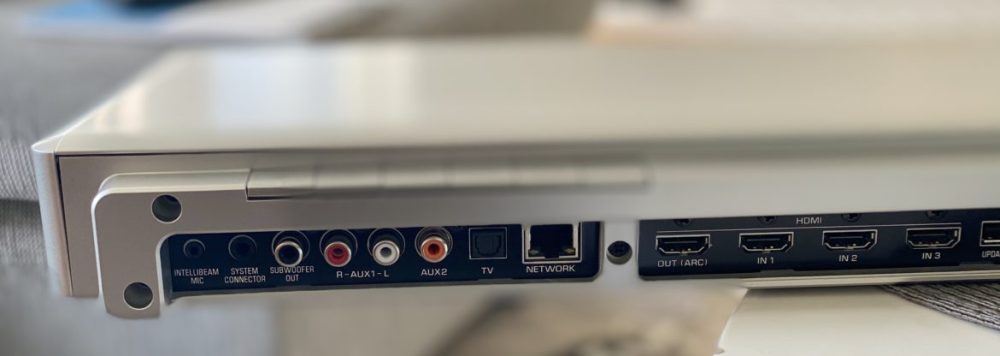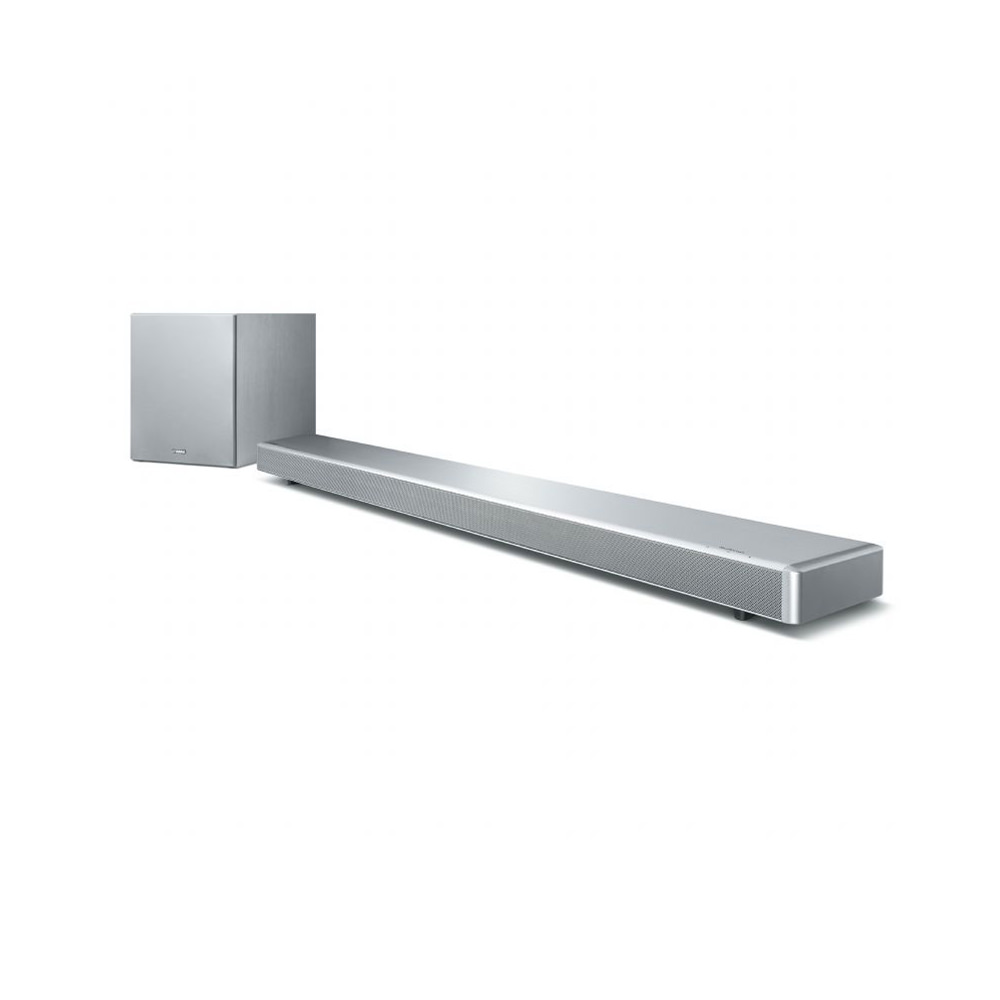TL;DR
Yamaha's YSP-2700 soundbar offers a surprisingly immersive audio experience, cleverly simulating surround sound with its 16 beam drivers. It boasts a sleek design, ample connectivity (including MusicCast and Bluetooth), and delivers robust sound quality for movies and gaming, even outperforming basic home theater setups in its price bracket. While it skips Dolby Atmos and has a slightly inconvenient display, it's a fantastic space-saving upgrade for those seeking impressive audio without the clutter of a traditional surround system. Curious if it's the right fit for your living room? Dive into the full review!
While senses.se values exceptional sound and true surround sound for home theaters, we recognize the prevailing trend towards streamlined setups and compact living spaces. The purpose of a soundbar is to simulate the effect of multiple discreetly placed speakers, delivering an immersive audio experience while maintaining a high degree of domestic harmony. Yamaha, a recognized leader in audio technology, offers the YSP-2700 system, promising comprehensive feature support – with the exception of Dolby Atmos. This review assesses the sound quality achievable with one (or two) speakers, compared to the configurations employing six or nine. senses.se puts it to the test.

Yamaha YSP-2700 – The Look
The Yamaha YSP-2700, initially launched in the summer of 2016, remains a prominent offering in Yamaha’s soundbar lineup. Our silver test unit presented a satisfactory aesthetic. The design is clean and understated. The color is a matte gray, and the system is also available in black, which may offer enhanced visibility for the built-in LCD display (details below). While appearing substantial at first glance, the soundbar’s dimensions are just under one meter in width, less than ten centimeters in height (excluding feet), and slightly over 15 cm in depth (944 x 91 (110 with wifi antenna extended) x 154 mm), with a weight of approximately 4 kg. The subwoofer, nearly a perfect cube, measures 295 × 297 × 307 mm and weighs 9.1 kg.

Connections on the YSP-2700
The rear panel provides a practical selection of connections. A primary HDMI output connects to your display, and three HDMI inputs accommodate source devices such as UHD/Blu-ray players, gaming consoles, or set-top boxes. All HDMI connections support HDCP 2.3, 4k@60fps, and HDR. While three inputs may seem limited in today’s HDMI-centric environment, this is often sufficient for soundbar users who typically manage fewer devices than traditional amplifier setups. The subwoofer can be connected via a wired connection (generally preferred for stability) or wirelessly (which performed reliably in our testing with no discernible impact on audio quality). Analog sources, such as external vinyl or CD players, can also be connected. Internet radio functionality is included.
The YSP-2700 incorporates Yamaha’s MusicCast multi-room audio system, enabling connectivity with other compatible speakers. Apple Airplay is also supported for Wi-Fi audio streaming. Bluetooth connectivity is available, including aptX codec support.

Yamaha YSP-2700: The Sound Quality
Setting up the YSP-2700 is a straightforward process. The on-screen guidance (available in multiple languages) directs users to run Yamaha’s automated sound optimization using the included microphone. This system analyzes room acoustics, measures sound levels, and assesses reflections (identifying objects that may impede or affect the soundstage) to optimize sound beam direction and channel volume. A symmetrical room devoid of sound-absorbent materials (e.g., heavy curtains) offers ideal conditions, but typical living spaces require some compromise. In our test environment, some sound leakage was noted to one side, and a slight lack of presence in the midrange was addressed by increasing the subwoofer level. These adjustments are easily implemented via the menu, which also facilitates Wi-Fi setup and software updates (also available via USB).
How does the YSP-2700 sound? In short, very good. When processing a high-resolution source with well-engineered surround sound, the system produces a surprisingly convincing illusion of an immersive soundfield. The soundbar incorporates 16 individual drivers, each angled in specific directions. Increasing the volume during playback of a well-produced musical film, such as Bohemian Rhapsody, creates an enjoyable experience. The subwoofer effectively reinforces the lower frequencies, contributing to the overall sonic immersion. While the system may not deliver the visceral impact of a full-sized subwoofer, the result is commendable for a compact two-component system.
We also evaluated gaming performance on our PS4 Pro. The YSP-2700 delivered impressive audio in this context as well. The compelling Western soundtrack of Desperados 3 filled the room, and the surround effects in The Last of Us: Part 2 heightened the sense of immersion. The YSP-2700 offers a vibrant and engaging sound profile, comparable to a basic surround amplifier and speakers in a similar price range.
The Yamaha YSP-2700 is compatible with a wide range of audio formats, including DVD-Audio, high-resolution lossless DTS-HD Master Audio, and Dolby TrueHD. Notably, it lacks support for Dolby Atmos and DTS:X. However, the practical impact of this omission may be limited, as differentiating between genuine Atmos mixes and downmixed 7.1 TrueHD/DTS-HD MA tracks can be challenging in blind listening tests.
A minor issue encountered when using the PS4 Pro with the YSP-2700 was occasional incorrect video signal transmission to our reference OLED Panasonic GZ2000 display. Initially, Full HD resolution and HDR were sometimes absent, but these issues were resolved by restarting the PS4. Similarly, the audio signal was consistently identified as PCM, even when Bitstream output was selected on the PS4. While this primarily affects the location of audio decoding (PS4 or amplifier) and has minimal practical consequence, the ability to verify the active audio track format would be desirable. This behavior may be specific to the PS4’s compatibility with the YSP-2700, as correct operation was observed with our reference UHD player from Panasonic.
The flaws with the YSP-2700
Considering its price point, the YSP-2700 has few significant drawbacks. However, the display implementation could be improved. A small, barely visible indicator light behind the metal grille indicates power status (green or red), and a basic LCD display shows the input name, but is difficult to read from a distance. An on-screen display for volume or mode selection (surround, stereo, input, etc.) is absent, requiring reliance on tactile button presses. This functionality does not appear to be configurable in the menu, which is a notable design oversight.
The “target” sound mode produces a narrow and tinny soundstage, seemingly intended as a “night mode” to focus audio in a single direction. However, headphones would provide a superior solution, especially given the compromised audio quality. While stereo (for music) and surround (for film and TV) modes are valuable, the “target” mode feels superfluous.
DSP (digital signal processing) modes are generally not recommended for discerning listeners, and their implementation here is unremarkable. The “Clear Voice” mode was perceived by some to enhance vocal clarity in TV broadcasts. This is subjective and merits experimentation, but carries the risk of introducing artificial artifacts, similar to overly aggressive “image enhancer” settings on televisions.
A true alternative to “real” home theater?
The Yamaha YSP-2700 excels in its primary function: delivering compelling audio. For a single unit under one meter in length, incorporating integrated speakers, an amplifier, and a wireless subwoofer, its performance is comparable to a basic home theater amplifier and a 7.1 speaker system priced under 10,000 SEK. While it does not match the sonic fidelity or power of a dedicated amplifier (such as our current reference Yamaha AVENTAGE A2080) or dedicated home theater speakers like our current references from Paradigm, that high-end setup costs approximately four times as much, without offering a fourfold improvement in sound quality.
The YSP-2700 is not among the least expensive soundbars available, and it exhibits some minor design shortcomings and lacks (unsurprisingly, given its 2016 release) the latest audio formats (Atmos). However, it provides genuinely impressive sound for users seeking a streamlined, space-saving solution who require connectivity for no more than three devices. It is not intended for hardcore home theater enthusiasts with extensive console collections, but rather for those who wish to significantly enhance their audio experience without incurring substantial costs or cluttering their living spaces with cables and large speakers. It is also a suitable option for improving audio in secondary rooms or vacation homes.
Yamaha delivers on the sound front. Once again.

